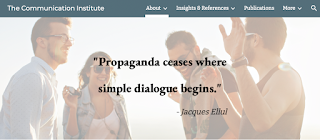Propagandists are weird. As far back as July 2021, this blog named the contemporary pseudo-populists in politics as "propagators of weird social beliefs."[1] Even then, the swill of truthiness, trash-talk, and outrageous screeches for the camera of these propagandists was so amplified that some perspective was required.
The plea in later blog posts was that it is:
...often safest and best to assume that a propagandist is weird, driven to develop extraordinary skills of self-preservation from probably a very early age, by a distorted commitment to being right and winning–at everything, by whatever means–including as an adult through remarkably protracted gaming of the legal system. All the lies, distortions, and dodges are tactics to prove to anyone who'll react that the propagandist is right and a winner, at your cost.[2]
Yet, the history of the word weird offers its own twists. Unsurprisingly with a living language, this word's story is, well, a bit weird.
Today, we mainly use weird to describe what's bizarre, cringeworthy, creepy, odd, peculiar, unusual, or eerie–with a strongly negative connotation. At the same time, Internet slang in its perversity can use weird to describe something unique or unconventional[3]–as a compliment, akin to how the word "Sick!" becomes a positive.
These are modern twists in the word's history from the Modern English period (c. 1500). In Middle English (c. 1100) connotations of the supernatural or uncanny were dominant. Mainly, before this, all the way back to the originally recorded Old English (c. 725), the word referred to fate or destiny and was often associated with supernatural or mystical beings.[4]
Other changes were to the word's spelling. The transition to "weird" came with the Anglo-Norman influence from the 1100s. Old Norse (c. 900) had adopted "urðr," referring to the fate or destiny of individuals–which was "often associated with the Norns, who controlled the destinies of gods and humans." Earlier, Old High German (c. 800) had ushered in the use of "wurt" in place of the original Old English "wyrd."[5]
This etymological story might serve as a timely warning. It'd be unfortunate and confusing if the Old English referent for what's "wyrd" as fate or destiny was in current use. Thank goodness we give the most common, modern meaning to "weird."
Its application to propagandists seems especially apt. What's really WEIRD are the obsessive energies of these zealots, who foment hate to target and marginalize any group not serving the propagandists' self-interest.
Nothing mysterious or supernatural here–just cruel perversion and self-obsession. If there's any othering worth doing, in the spirit of George Orwell's urging,[6] what is needed are ongoing efforts at scale to drive the lies and drivel of propagandists "into the dustbin" where they belong.
References
1. Word to the Wise blog (2021), To Strengthen Democracy, July 30, https://communicator.rodney-miller.com/2021/07/to-strengthen-democracy.html
2. Word to the Wise blog (2022), Certainty Claims, April 22, https://communicator.rodney-miller.com/2022/04/certainty-claims.html
3. WikiEtymology (2024), "Etymology of Weird," https://wikietymology.com/w/etymology-of-weird/
4. WikiEtymology (2024)
5. WikiEtymology (2024)
6. George Orwell (1981), “Politics and the English Language,” A Collection of Essays, Orlando, FL: Harcourt, p. 171 [1st published 1946]













.jpeg)
.jpeg)

